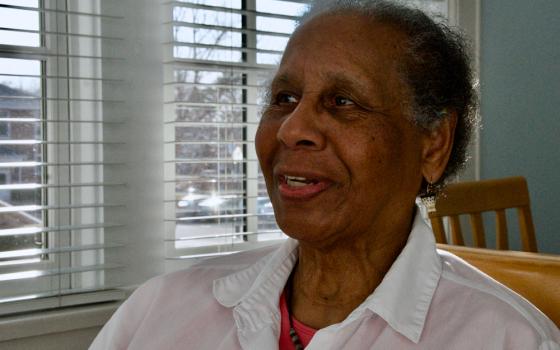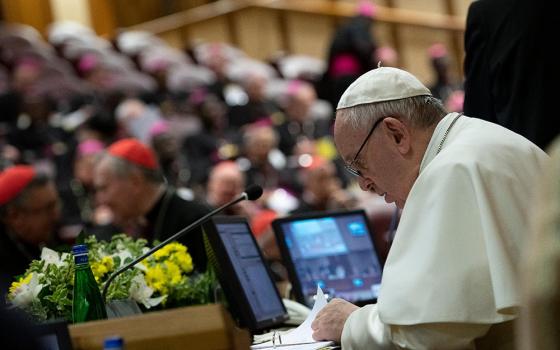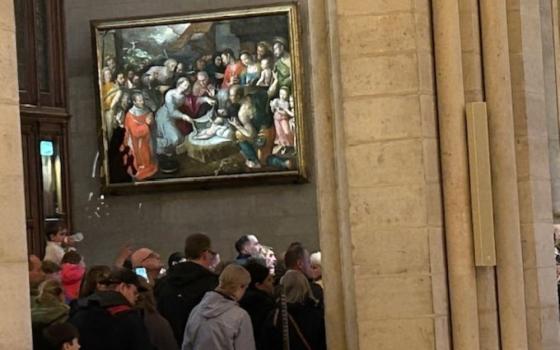
(Photo: Wikimedia Commons/https://creativecommons.org/licenses/by-sa/4.0/)
There she is, among the infirm homeless of New York. She is a woman from my community, Sisters for Christian Community (SFCC). She goes far beyond the limits of the Christian community.
After many years in the Sure We Can project, Ana has discerned her call to create a home for the most abandoned in society. Her commitment is evident, and she is already building small houses for the most vulnerable, those in the heart of New York who are homeless and affected by disease. These are people who are not wanted anywhere, neither by their families nor on the streets. And, of course, they have no health insurance.
Ana feels called to serve these people, and she dedicates her whole being to this. If she has to talk to the mayor, she does it; if she has to deal with politicians to get grants and permits, she is there, too. If she has to plant tomatoes and build small dwellings with volunteers, she rolls up her sleeves and works together with them. She is a sister to the homeless, to those who are ignored by their families because of their addictions, to today's lepers.
"In contrast to the imposing cathedrals in [New York], [Sister] Ana builds her own temple: small houses for those who have lost everything in life, even the possibility of a roof and a family hug." — Sr. Magda Bennásar
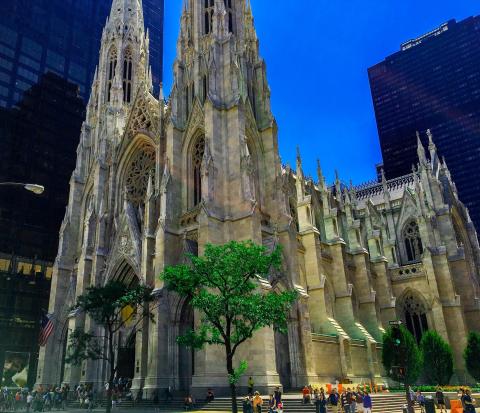
In the financial heart of the world, the rhythm of Sr. Ana Martinez de Luco's heart beats in a different way. (Courtesy of St. Patrick's Cathedral, New York, USA)
The rhythm of this woman's [Ana's] heart beats in a different way in the financial heart of the world.
In contrast to the imposing Catholic and Episcopalian cathedrals that emerge beautiful and powerful in this city, Ana builds her own temple: small houses for those who have lost everything in life, even the possibility of a roof over their heads and a family embrace. There, Ana emerges as an icon of biblical hospitality, so valued by Jesus and his disciples who needed to be welcomed in the places where the mission led them.
Ana's ministry reminds me of Leonardo Boff's reference to the impact of the butterfly effect, related to Lorenz/Prigogine's chaos theory: "The flapping of the wings of a butterfly in Brazil can cause modifications in the atmosphere that can culminate in a storm in New York. The theoretical assumption is that all things are interlinked and take on new elements, creating complexities in the course of their evolution."
Throughout history, there has always been a woman or a group of women who unnoticed, change, transform, shape and construct the future.
Our Ana is called today's Dorothy Day. She is Basque and speaks very little, but when she does, she smiles. It is her gestures that embody the Gospel. When I look at her, "the Anas" in the world emerge from within me. There are so many who give their all, so many who expose themselves to the full, and do so because they trust in "the One who is faithful," and in the intrinsic goodness of human beings.
We see, in the First Book of Kings 17, 10 - 16, how a widow — a person without resources of any kind at that time — is asked to share all that she has left, and she does. Thanks to this act of abandonment, she experiences God's faithfulness poured out upon her. This is the strength of "our Anas," anonymous in both the Gospel and today's reality. The strength of these women lies in their relationship with the All Who brings out the best in them and impels them to absolute risk for love of the Absolute.
The widow, a vulnerable member of society, represents the faithful community that, even in the midst of a very corrupt ecclesial reality — as we see it now and which horrifies so many — continues to love God as its companion on the way.
"But what would the disciple of today be like? As we incarnate her: free and educated, a woman of prayer, someone who is passionate about the Gospel and (...) is not afraid of the elements."
— Sr. Magda Bennásar.
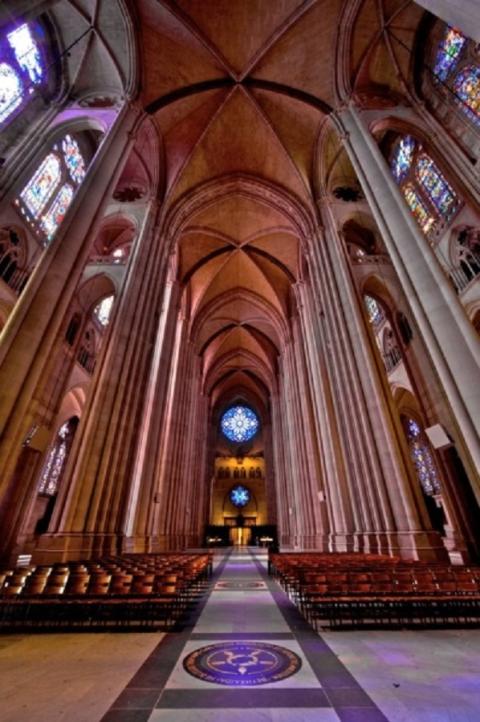
Ana Martinez de Luco's "cathedral" is very close to the majestic Catholic and Episcopalian Cathedrals of New York but in the embrace of Abba on the street. (Courtesy of Cathedral of St. John the Divine, New York)
In the same way, the widow we contemplate in Mk 12, 42 - 44 embodies the quality of love that Jesus tries to communicate by depositing all that she has for her sustenance in the treasury of the temple offerings; so different from the leaders who are unfaithful to God, and who prioritize their love of money and moral power over others. Jesus is moved and empowers her when he sees her, as He does when He sees you doing the same: perhaps being the "Anas" of today, sharing all that you have with your children and refugees; or greeting refugee women in the supermarket, as I saw yesterday — a Spanish grandmother laughing with women covered in fabrics and facemasks mistaken for burkas.
These women could be Moroccan, Pakistani, Afghan or Syrian. I don't know, but their laughter made me realize how young they were. They were veiled; the men [accompanying them] were not, of course. These are subtle details that make women invisible and silence those who could be educators or health workers in their own countries but who have to live in exile because, in the temples and palaces, there are petty characters on the payroll and also in positions of power.
The widow represents the model disciple, but what would today's disciple be like? As we incarnate her: free and educated, a woman of prayer, someone who is passionate about the Gospel and, like "our Anas," is not afraid of the elements.
In some cases, this woman and disciple will face the harsh reality of homelessness, like in New York and so many other places; more often than not, she will face the "elements" of lack of recognition and support, as has always been the history of women.
I do not pretend to guess the future, but from my gut to my brain, I see and feel very clearly that the Church of Jesus — that is, Christian communities in general — will only be resurrected when "the Anas" of today join their butterfly flutter with the storm that Jesus provokes when He enters into people's lives.
I like Ana's Cathedral. It is close to the majestic Catholic and Episcopalian Cathedrals of New York; but like Jesus, it breaks away from the temple and its rigidities to become the embrace of Abba in the street, in the snow, amidst alcoholism and sickness. Ana gets up and — as the sister who represents them all — participates in Al-Anon groups. She grows fond of the old Jewish woman whom she takes care of to earn a few dollars to live; and she tells us in the monthly "sharing and celebrating Zoom call" that all of this helps her to appreciate more and more the Jesus who took so many of us out of our comfortable lives to launch us into His mission and work.
I believe that the widow is not the only model of discipleship. But when Jesus sees her pouring all that she has to live on into the treasury… the man melts. I believe it! He, too, is "fed up" with the clericalism, dirty politics and abuses of power in the name of a religion that exists only in the minds of its organizers. And when He sees that woman, He sees in her what He cannot awaken in them. For this reason, perhaps, they do not receive her because they feel threatened by her radical and faithful discipleship.
Advertisement
"I like Ana's cathedral. It is close to the cathedrals of New York; but like Jesus, it separates itself from the temple and its rigidities to become the embrace of Abba in the street, amidst alcoholism and illness." — Sr. Magda Bennásar
I know other women who are not named Ana but who embody the pure Gospel, like my friend whose husband was killed by ETA in the doorway of her house; and since then, she has dedicated herself to talking about reconciliation in educational centers all over Vizcaya. Or Belén, another friend, who despite her Parkinson's disease and the suicide of her daughter because of depression, dedicates herself to visiting and calling elderly and lonely people every day, bringing them, with her fluttering wings, the nearness of the One who is faithful.
I am sure you also know several "Anas." In fact, maybe you are one of them. For this reason, we thank you all. We see you in your cathedral homes, authentic places of Christian community where there is always a welcome, biscuits and love. What Eucharist! Even if it is online, as it has been recently for many people, it continues to unite the "Anas" from different countries and continents. They do not stop! They are incombustible! That is why the Christian community is still alive in the streets, on screens and in homes.
That's where we see each other, Sisters, whether in New York, Nicaragua, your neighborhood or on a video call.




